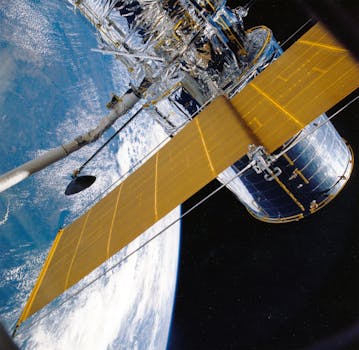MEO Satellites: Revolutionizing Global Connectivity with Medium Earth Orbit Technology – MEO Satellites

MEO Satellites: Introduction to Medium Earth Orbit Technology – MEO Satellites
MEO satellites, or Medium Earth Orbit satellites, are a type of satellite that operates in an orbit between 2,000 and 36,000 kilometers above the Earth’s surface. This orbit is significantly lower than the Geostationary Orbit (GEO), which is approximately 36,000 kilometers above the equator, and higher than the Low Earth Orbit (LEO), which is typically below 2,000 kilometers. The unique position of MEO satellites provides several advantages, including lower latency, higher bandwidth, and improved coverage. MEO satellites are designed to provide a range of services, including telecommunications, navigation, and Earth observation. They are particularly useful for applications that require high-speed data transfer, such as broadband internet, video conferencing, and remote sensing. The use of MEO satellites is becoming increasingly popular due to their ability to offer faster and more reliable connections compared to traditional GEO satellites.
How MEO Satellites Work
MEO satellites work by using a network of satellites in Medium Earth Orbit to provide continuous coverage of the Earth’s surface. Each satellite is equipped with a range of instruments, including transponders, antennas, and propulsion systems. The satellites communicate with ground stations and other satellites using radio waves, allowing them to transmit and receive data. The orbit of MEO satellites is carefully designed to provide optimal coverage and minimize interference. The satellites are typically placed in a highly elliptical orbit, which allows them to spend more time over a particular region of the Earth’s surface. This provides a higher level of coverage and reduces the number of satellites needed to achieve global coverage.
Advantages of MEO Satellites
MEO satellites offer several advantages over traditional GEO satellites. One of the main benefits is lower latency, which is the time it takes for data to travel from the Earth’s surface to the satellite and back again. MEO satellites have a latency of around 20-30 milliseconds, compared to 250-300 milliseconds for GEO satellites. This makes MEO satellites ideal for real-time applications, such as video conferencing and online gaming. Another advantage of MEO satellites is higher bandwidth. MEO satellites can provide higher data transfer rates due to their closer proximity to the Earth’s surface. This makes them suitable for applications that require high-speed data transfer, such as broadband internet and remote sensing. MEO satellites also offer improved coverage, particularly in areas with limited or no access to traditional communication infrastructure. They can provide connectivity to remote or underserved communities, helping to bridge the digital divide and promote economic development.
Applications of MEO Satellites
MEO satellites have a range of applications, including telecommunications, navigation, and Earth observation. They are used to provide broadband internet, mobile phone coverage, and other communication services to remote or underserved communities. MEO satellites are also used for navigation, providing location information and timing signals for a range of applications, including aviation, maritime, and land transportation. In addition, MEO satellites are used for Earth observation, providing high-resolution images of the Earth’s surface for applications such as environmental monitoring, disaster response, and urban planning. They can also be used for remote sensing, providing data on soil moisture, crop health, and other environmental parameters. MEO satellites are also being used for scientific research, providing a platform for studying the Earth’s atmosphere, oceans, and land surfaces. They can be used to monitor climate change, track weather patterns, and study the Earth’s magnetic field.
Conclusion
MEO satellites are transforming the way we communicate globally, offering faster and more reliable connections. With their lower latency, higher bandwidth, and improved coverage, MEO satellites are ideal for a range of applications, including telecommunications, navigation, and Earth observation. As the demand for satellite-based services continues to grow, MEO satellites are likely to play an increasingly important role in providing global connectivity and promoting economic development.




